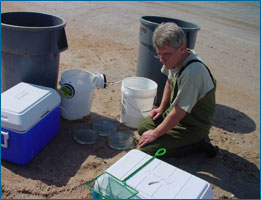
Whatever the solution, it’s clear that our fisheries and our oceans are in trouble. David points out that “we’ve removed almost all the big fish from the sea…and it’s not just the potential for evolutionary change, it’s the ecological changes as well: we’ve lost coral reefs due to coral bleaching, we’ve polluted many of our coastal waters. So there’s a variety of problems that relate to this fisheries crisis. It’s not just one thing — but a lot of it is over-harvest.”
David’s research highlights the importance of looking beyond ecology to the evolutionary effects of our actions — in our oceans, rivers, forests, fields, and even farms, because wherever there is life, there is evolution. As David puts it, “The thing is that evolution is universal to life — it doesn’t matter whether you’re in the ocean, or whether you’re in the streams of Trinidad, or whether you’re a grayling [a relative of salmon] in the lakes of Scandinavia, or whether you’re a bighorn sheep up in the mountains. It’s the same principle.” And if we learn to expect evolution in these living systems, then we can plan for it and even use it to our advantage — to protect and preserve the diversity of life on Earth upon which we depend.
Discussion and extension questions:
- What is artificial selection and how does it lead to evolution?
- How is artificial selection different from natural selection? How is it similar to natural selection?
- David argues that “throwing the little ones back” makes sense from an ecological perspective, but not from an evolutionary one. Explain the basis of that argument.
- One solution to the problem of fish evolving smaller body sizes is to change fishing regulations so that only medium-sized fish could be kept. Explain how that strategy would help maintain genetic variation in wild fish populations.
- This article discusses several examples of correlated traits in fish. In mosquitofish, there is a correlation between darker body color and high levels of aggressiveness. Imagine that you maintain a population of mosquitofish for many generations, and each generation, you remove all the least aggressive fish before they can reproduce. How would you expect aggression level to change in this population? How would you expect coloration to change in this population? Why?
- This article described one example of evolution through artificial selection. Research another example of evolution through artificial selection. Explain what selective factor drove the evolution and how that affected the population.
Get tips for using research profiles, like this one, with your students.
